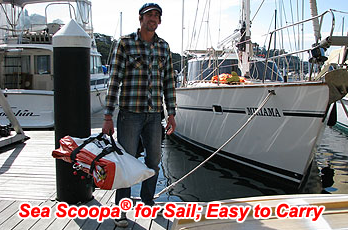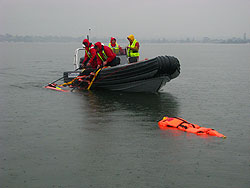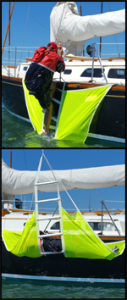Prevent
The best way to handle the man overboard situation is to prevent man overboard from happening through use of harnesses and strong fastening points or jack lines, which run from bow to stern, or stern to stern via the bow, and the like. The saying, Keep one hand for yourself,
reminds the sailor that his safety is his personal responsibility. Risky behavior, ignorance, lack of preparation, lack of anticipation, or stupidity are not rewarded. See bottom of this page for a link to an article on the US SAILING site about how to remain on board.
Mark Location
Failing that, if you are aware your crew has just immediately fallen overboard, do the following:
- Immediately yell,
Man Overboard!
- This alerts your crew on your boat
- It alerts any others in vicinity too
- It tells MOB he was seen going overboard
- Immediately throw the person some flotation (better yet, a dan buoy1)
- Have one crew be
the spotter
- This person’s only job is to maintain eye contact with the victim or victim’s location and point there
- Mark the person’s location using GPS or similar: press the MOB button, or SAVE / MOB button on the GPS
- If enough crew is available, have someone other than the spotter push the button on the GPS
- Promptly and safely recover the crew by the method you have trained on
Footnotes
1ISAFWorld Sailing & US Sailing writings (as of , the publication date of this page) suggest you not deploy a traditional man overboard pole until you reapproach victim’s proximity. Rationale was that the device takes too long to deploy to be useful. Technology has evolved since that analysis. The SOS Marine self–inflating (and self–contained) man overboard dan buoy is far easier to deploy than the good old MOB pole.
You deserve to know that the dan buoy is available. It enables easy, quick deployment and merits your consideration.
The device used to mark location of the person overboard should
- be as quick and as easy as possible to deploy by anyone onboard
- provide additional flotation
- be highly visible
- be easily findable day, night, and in fog
- not be blown from its location
The dan buoy is such a device. It is easily kept near the helm and just thrown to a person overboard. Upon submersion, the dan buoy automatically inflates in about seven seconds. It uses the same inflation mechanism as an inflatable life jacket and is tested to ISO standard 12402 which applies to inflatable life jackets. The inflatable dan buoy is new to many people in north America. It satisfies US Sailing’s requirement to carry a man overboard pole. It is highly popular in Australian yachting circles; learn more about it!
Search
Failing to mark the position of crew overboard, or in the event crew has gone overboard unnoticed, you may find yourself resorting to search. There are a number of new personal locator beacons on the market and similar devices to help lead a yacht to an overboard crew. We are still studying these. Assuming nothing like this went over with the crew, there are standard search patterns to employ and, if within range, emergency responders to coordinate with. Read the story of a lobster fisherman located by search. Emergency responders such as the Coast Guard have sophisticated modeling and coordination systems, and experienced personnel, to help locate sailors lost at sea. Call for assistance and chances are likely you will become part of one of the following searches combining computer resources, manpower, vessels and aircraft.
- Reference
- Unless otherwise noted, refer to: Canadian Coast Guard Auxiliary Search & Rescue Crew Manual, Chapter 9: Search
- Barrier Search
- Used where pronounced current exists; let current bring person to you
- Trackline Search
- Travel along vessel’s track, offset to one side, then travel back in the opposite direction of that track, offset to opposite side
- Expanding Square Search
- Making ninety degree turns to travel along the edge of ever larger squares through search area
- PowerPoint presentation by USCG Auxiliary, Ocean City, NJ
- Creeping Line Search
- Search legs parallel to search area's minor axis
- Use when odds favor finding person toward one end of search area rather than the other
- Parallel Search
- Search legs parallel to search area's major axis
- Use when even odds of finding person anywhere within search area
- Sector Search
- Criss-crossing through a center point as though spokes of a wheel
Recover
There are many opinions on what is the best method or best search pattern to effect recovery of the man overboard. Every one of them is useless if you have not trained how to do it. Do not expect that you will be prepared to save a life if you read about man overboard rescue turns
once. The best man overboard recovery method for you and your crew is the one you have practiced.
ISAF World Sailing suggests you train on the Quick–Stop method. Note: this method may not be appropriate for the newest, fragile, fast–moving sailing yachts!
There is new equipment purpose–engineered for man overboard recovery. Sea Scoopa is ideal for yacht club race committees, rescue organizations, or sailors who must be self–reliant. SAIL Magazine Executive Editor Charles J. Doane wrote that Sea Scoopa is:
…the only gear we’ve ever used that truly does make it possible to recover an unconscious or absolutely disabled MOB victim from the water without getting in yourself.
The SOS Recovery Ladder is a new lower cost dual–use MOB recovery device. Fit, able crew can climb its ladder or injured, even hypothermic crew, can be parbuckle lifted from the water. We also have an MOB recovery gear comparison which describes the differences and suitability of different types of man overboard retrieval devices.
Further Reading
Chris Caswell wrote an article for Yachting titled, Man Overboard, posted October 2007. It is dated but still worth reading.

Peter Isler has written a solid article, published on the US Sailing site, dated 15 September 2015. It’s titled, Man Overboard Recovery Procedure; it’s very much worth reading.
Proactive readers will be interested in, Crew Overboard Prevention: How to Remain Aboard, on the same site.
The CCA publishes excellent resources on Safety at Sea. Read Man Overboard Recovery for Shorthanded Cruisers. The Safety at Sea and Seamanship sections of the CCA web site are also great resources.





